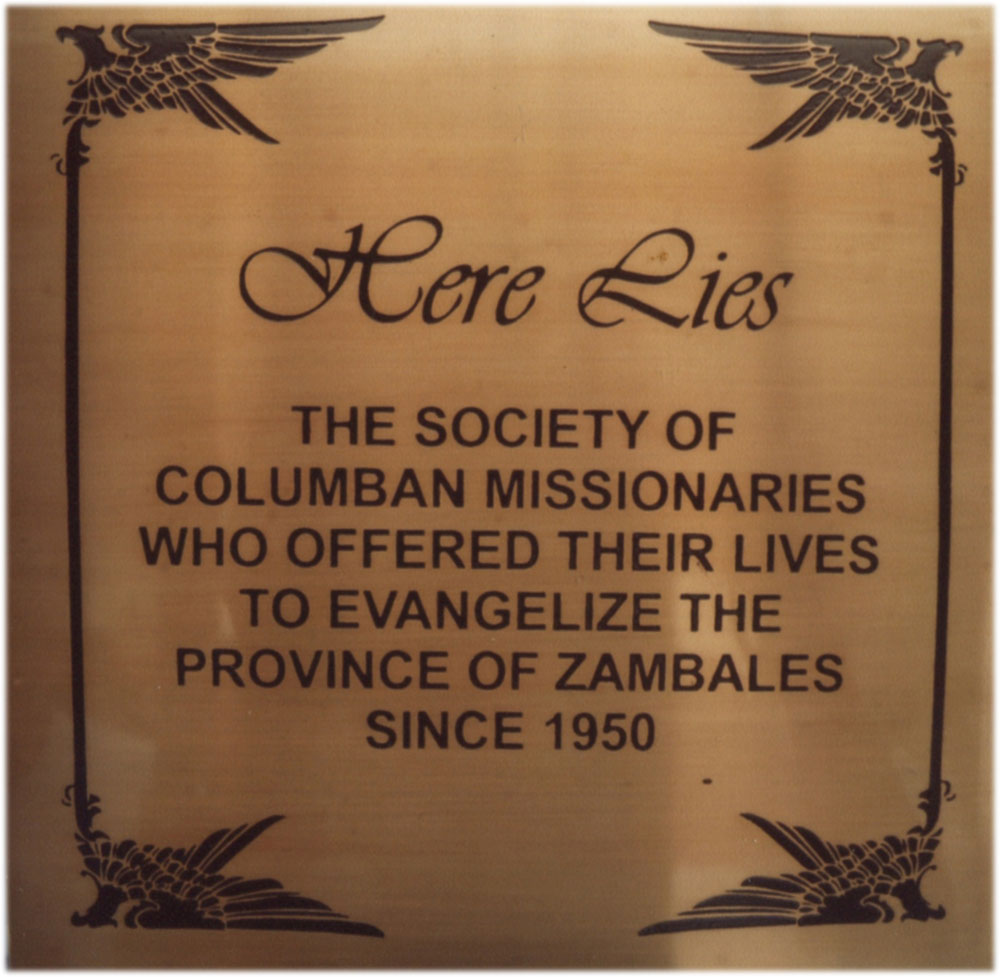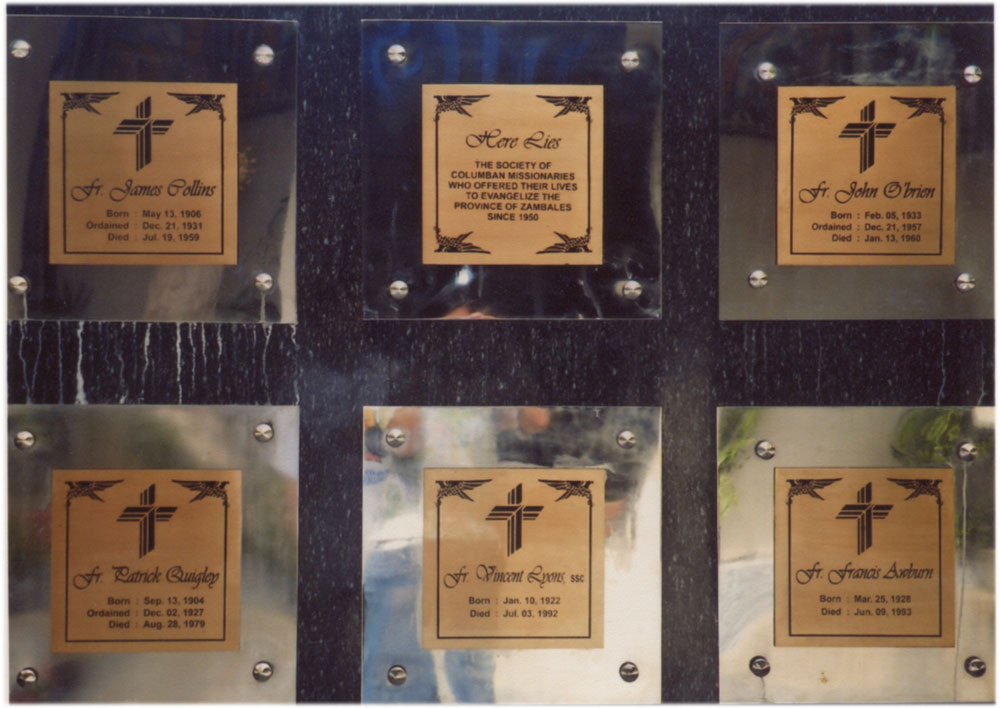Deceased Columbans In Zambales
By Fr Patrick J. Baker
 Since the Columbans first went to the Province of Zambales in 1951, around 70 of them served for varying lengths of time. The area became the Prelature of Iba in 1955 and a diocese in 1982. Columban Bishop Henry Byrne was bishop from 1956 until 1982. The last two Columbans to staff a parish there were Frs Fintan Murtagh and Donal O’Dea. They turned over the parish of the Immaculate Conception, Barretto, Olongapo City, to the Diocese of Iba on 20 May this year. That leaves just one Columban remaining in the Diocese – Fr Shay Cullen in the Preda Center.
Since the Columbans first went to the Province of Zambales in 1951, around 70 of them served for varying lengths of time. The area became the Prelature of Iba in 1955 and a diocese in 1982. Columban Bishop Henry Byrne was bishop from 1956 until 1982. The last two Columbans to staff a parish there were Frs Fintan Murtagh and Donal O’Dea. They turned over the parish of the Immaculate Conception, Barretto, Olongapo City, to the Diocese of Iba on 20 May this year. That leaves just one Columban remaining in the Diocese – Fr Shay Cullen in the Preda Center.
The turn-over ceremony, with the installation of the new parish priest, Fr Rodel San Juan, took place within a Mass in Barretto parish church. It was a very well prepared ceremony, with Bishop Florentino G. Lavarias presiding and most, if not all of the priests of the diocese, attending. Many tributes were paid to the Columbans who had served in Iba for the past 60 years. The Regional Director, Fr Pat O’Donoghue, expressed the gratitude of the Society for the welcome, acceptance and cooperation that the Columbans had experienced during those years.

Deceased Columbans in Zambales
Inspired by this ceremony the Diocese came up with a plan to pay tribute to the six Columbans who had given their lives for the people of Zambales and were buried there:
Bishop Henry Byrne – who died 24 July 1983;
Fr James Collins – 19 July 1959;
Fr John O Brien – 13 January 1960;
Fr Patrick Quigley – 28 August 1979;
Fr Vincent Lyons – 3 July 1992;
Fr Francis Awburn - 9 June 1993.
Father Awburn was Australian while the others were Irish.
Bishop Byrne was buried in the Cathedral of St Augustine in Iba, the others in the cemetery in Sta Rita Parish, Olongapo City. But the Diocese was concerned that if there were no longer any Columbans in the area to look after the graves of the five they might be neglected. One of the priests most concerned was Monsignor Crisostomo A. Cacho, Vicar General of the Diocese and current President of Columban College, Olongapo City. He was born and raised in San Marcelino when it was a Columban parish. He wanted to become a Columban but it was not possible in those days. He has remained very close to the Columbans until now. Also very concerned was the parish priest of St Columban Parish, Olongapo City, Fr Audencio M. Mozo Jr. These two initiated a discussion with Bishop Lavarias and the priests. They made arrangements to disinter the remains of the five in Sta Rita, cremate them, and place the ashes in marble urns. Thanks to the concern and generosity of Fr Mozo and the people of St Columban Parish, a special columbarium was constructed at the side of the church.
The placement of the urns in the columbarium was scheduled to coincide with an anniversary Mass for the late Bishop Byrne on 25 July. Fr Pat O’Donoghue was invited and Fr Pat Baker accompanied him as Regional Archivist. It would be important to have a record of such an historical event.
The parish church was absolutely packed for the 5:00 pm Mass. Bishop Lavarias was the main celebrant and homilist. About 20 priests concelebrated. In his homily the Bishop paid great tribute to Bishop Byrne and to all the Columbans who had served in the diocese, especially to the five whose remains were in the urns on display in the sanctuary.
At the conclusion of the Mass Fr O’Donoghue was invited to respond on behalf of the Society. He stressed the continuing bonds between the diocese and the Columbans and sincerely thanked the Bishop, clergy and laity who had worked together to bring the five Columbans together once more where they had often been together in life. He commented that you can judge a community by how they care for their dead and so this act of reverence for the Columban dead witnessed once more to the goodness and kindness of the people of Zambales in their love for the Columbans. It was a deeply touching and very inspiring gesture that would never be forgotten.
Then the urns were taken in procession to the columbarium. It had been specially constructed into the outer wall of the church, just for the five Columbans. It was made of solid steel with polished brass trimmings and a brass plaque for the door of each niche containing an urn. In addition there was a larger polished brass plaque with a tribute to all the Columbans who had served in the diocese.
It was a very moving ceremony. We two Columbans were overwhelmed by the number of people who came to greet us, to thank us for the many Columbans who had served there, to ask us about the ones whom they had known best. We left with a conviction that a large part of the Columban legacy will live on in the diocese for years to come. Also that our six confreres will be well looked after.
1 August 2011
You may email Father Baker at pbaker1956@gmail.com
Editor’s Note
‘Columbarium’ is a Latin word derived from ‘columba’, the Latin for ‘dove’. One of its meanings is a vault with niches for the cremated ashes of the dead. St Columban’s name means ‘white dove’. So there is a special appropriateness to the last resting place of the six Columbans in the Diocese of Iba.

